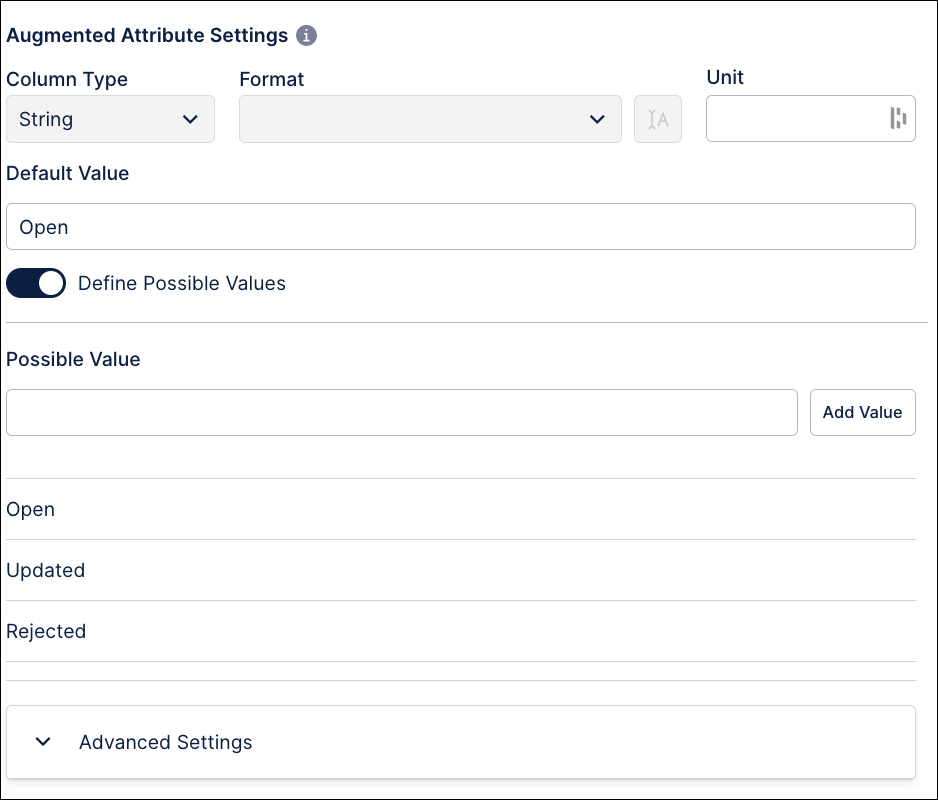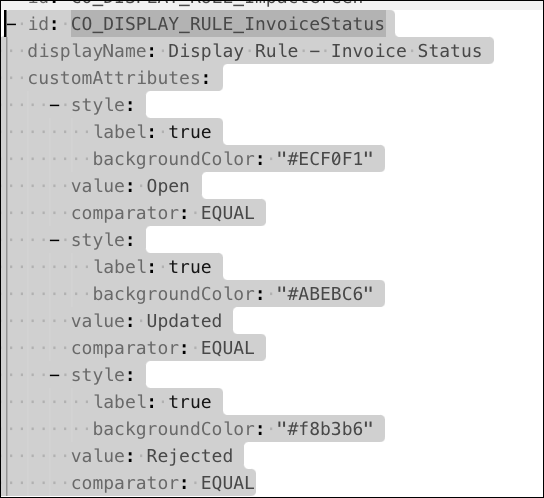Configuring augmented attributes for the case-centric Baseline Date Optimizer app
In the Baseline Date Optimizer app’s Knowledge Model “Baseline Date Optimizer - Knowledge Model”, configure any additional values you want for the augmented attributes. You only need to do this if there’s something important to add besides the supplied values.
Invoice status: The status of invoices is displayed in the Status column of the Action View table. The possible status values are listed in the attribute Status of the record item Invoice (Credit) (which has the ID AP_RECORD_VendorAccountCreditItem) in the Knowledge Model. Users can set an invoice’s status to one of these values to track its progress. The supplied status values that users can pick are "Open", "Updated" and "Rejected". You can’t remove these status values.
Vendor status: The status of vendors is displayed in the Configuration view (tab “Action View Configuration”) and in the Value Assessment view in the vendor table. The possible status values are listed in the attribute Vendor Action View Status of the record item Vendor Master Company Code (which has the id AP_RECORD_VendorMasterCompanyCode) in the Knowledge Model. When users set a vendor’s status to “Active”, open invoices from that vendor with an unfavorable baseline date mismatch are shown in the Action View. The default status for a vendor is “Inactive”. You can’t remove the “Inactive” and “Active” status values.
You work with Knowledge Models in the visual editor in Studio, and any changes you make are applied when you publish a new version of the app.
Here’s how to set up any new status values that you want to add. We’ll explain the steps using the invoice status, and give you the alternatives for if you’re working with the vendor status.
In the Celonis navigation menu, select Studio.
Find the Baseline Date Optimizer app in your Studio space navigation.
Expand the package’s structure using the arrow.
Go to the Knowledge Models folder and select “Baseline Date Optimizer - Knowledge Model”.
Select the Records section of the visual editor, and search for “Status” to find the relevant records.
Tip
You can hide auto-generated items in the Knowledge Model by clicking the “Hide auto-generated definitions” icon next to the search bar.
In the row “Invoice (Credit)” for invoice status (or "Vendor Master Company Code" for vendor status), click the arrow in the Record Items field to open the augmented attributes. Click the attribute Status (or Vendor Action View Status) to edit it.

Scroll down to the Augmented Attribute Settings section, and enter each of your new status values in the Possible Value box, then click Add Value to add it to the list. Click Save to save the new values.

Review the KPIs and Filters that use the augmented attributes. The status values are used in these filters and for the value realization, so add your new values where appropriate.
VendorAccountCreditItem (Invoice status)
AP_Filter_VendorAccountCreditItem_BaselineDateOptimizationStatusIsOpen (Filter)
AP_Filter_VendorAccountCreditItem_BaselineDateOptimizationStatusIsRejected (Filter)
AP_Filter_VendorAccountCreditItem_BaselineDateOptimizationStatusIsUpdated (Filter)
VendorMasterCompanyCode (Vendor status)
AP_Metric_VendorAccountCreditItem_COUNTDISTINCT_BaselineDateIncreasesFromActiveVendors (KPI)
AP_Filter_VendorMasterCompanyCode_ActionViewVendorActive (Filter)
Optional: At the moment, your new status values will be displayed with the default “Queued” icon that’s used for all status values without their own icons. If you want them to have their own icons, you’ll need to replace the custom object that holds the display rule for the invoice status or vendor status. Here’s how to do this:
In the visual editor for “Baseline Date Optimizer - Knowledge Model”, click the Switch to YAML icon </> to view the YAML for the Knowledge Model.

Click inside the YAML editor to access the editor’s own search function (instead of your browser search, which won’t work), then press Ctrl + F and search for the custom object CO_DISPLAY_RULE_InvoiceStatus for invoice status (or CO_DISPLAY_RULE_ActionViewVendorStatus for vendor status).

Copy the whole of the custom object, then click Edit Mode. The custom object comprises the ID, display name, and the list of custom attributes for the styles, each with a label, background color, value, and comparator.

Paste the custom object into the customObjects section of the YAML. Change the ID to something different, such as CO_DISPLAY_RULE_InvoiceStatus_CUSTOM.
Add a custom attribute for each of your new status values, including a suitable icon for each of them. Click Save and Exit Edit Mode to finish, then click the palette icon to switch back to the visual editor.
In each of the tables where a display rule for the invoice status (or vendor status) is used, apply your new custom object instead of the preset custom object. Click the Edit Component button on the table to go to the component editor, then find the value setting for the status in the table settings. Specify your new custom object for the styling rule, and click Save.
Go to the Action View and check that your new values are available in the Status dropdowns for the invoices (or vendors), and showing the icons you expect.
When you’ve completed and checked your changes, use the Publish Package button at the top of the screen in your Studio space to publish a new version of the app.